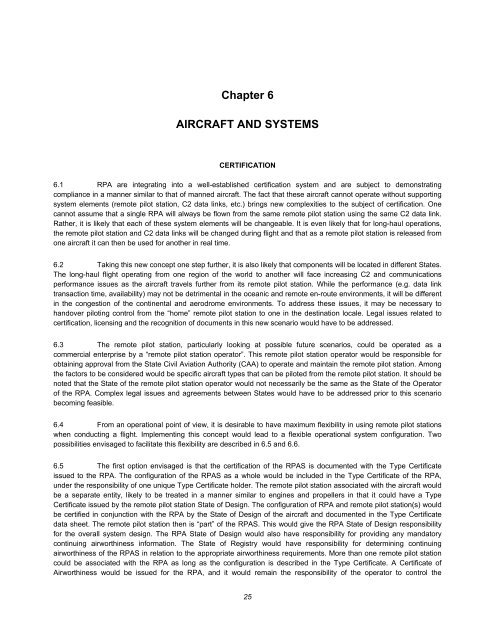1AswVkP
1AswVkP
1AswVkP
You also want an ePaper? Increase the reach of your titles
YUMPU automatically turns print PDFs into web optimized ePapers that Google loves.
Chapter 6<br />
AIRCRAFT AND SYSTEMS<br />
CERTIFICATION<br />
6.1 RPA are integrating into a well-established certification system and are subject to demonstrating<br />
compliance in a manner similar to that of manned aircraft. The fact that these aircraft cannot operate without supporting<br />
system elements (remote pilot station, C2 data links, etc.) brings new complexities to the subject of certification. One<br />
cannot assume that a single RPA will always be flown from the same remote pilot station using the same C2 data link.<br />
Rather, it is likely that each of these system elements will be changeable. It is even likely that for long-haul operations,<br />
the remote pilot station and C2 data links will be changed during flight and that as a remote pilot station is released from<br />
one aircraft it can then be used for another in real time.<br />
6.2 Taking this new concept one step further, it is also likely that components will be located in different States.<br />
The long-haul flight operating from one region of the world to another will face increasing C2 and communications<br />
performance issues as the aircraft travels further from its remote pilot station. While the performance (e.g. data link<br />
transaction time, availability) may not be detrimental in the oceanic and remote en-route environments, it will be different<br />
in the congestion of the continental and aerodrome environments. To address these issues, it may be necessary to<br />
handover piloting control from the “home” remote pilot station to one in the destination locale. Legal issues related to<br />
certification, licensing and the recognition of documents in this new scenario would have to be addressed.<br />
6.3 The remote pilot station, particularly looking at possible future scenarios, could be operated as a<br />
commercial enterprise by a “remote pilot station operator”. This remote pilot station operator would be responsible for<br />
obtaining approval from the State Civil Aviation Authority (CAA) to operate and maintain the remote pilot station. Among<br />
the factors to be considered would be specific aircraft types that can be piloted from the remote pilot station. It should be<br />
noted that the State of the remote pilot station operator would not necessarily be the same as the State of the Operator<br />
of the RPA. Complex legal issues and agreements between States would have to be addressed prior to this scenario<br />
becoming feasible.<br />
6.4 From an operational point of view, it is desirable to have maximum flexibility in using remote pilot stations<br />
when conducting a flight. Implementing this concept would lead to a flexible operational system configuration. Two<br />
possibilities envisaged to facilitate this flexibility are described in 6.5 and 6.6.<br />
6.5 The first option envisaged is that the certification of the RPAS is documented with the Type Certificate<br />
issued to the RPA. The configuration of the RPAS as a whole would be included in the Type Certificate of the RPA,<br />
under the responsibility of one unique Type Certificate holder. The remote pilot station associated with the aircraft would<br />
be a separate entity, likely to be treated in a manner similar to engines and propellers in that it could have a Type<br />
Certificate issued by the remote pilot station State of Design. The configuration of RPA and remote pilot station(s) would<br />
be certified in conjunction with the RPA by the State of Design of the aircraft and documented in the Type Certificate<br />
data sheet. The remote pilot station then is “part” of the RPAS. This would give the RPA State of Design responsibility<br />
for the overall system design. The RPA State of Design would also have responsibility for providing any mandatory<br />
continuing airworthiness information. The State of Registry would have responsibility for determining continuing<br />
airworthiness of the RPAS in relation to the appropriate airworthiness requirements. More than one remote pilot station<br />
could be associated with the RPA as long as the configuration is described in the Type Certificate. A Certificate of<br />
Airworthiness would be issued for the RPA, and it would remain the responsibility of the operator to control the<br />
25


